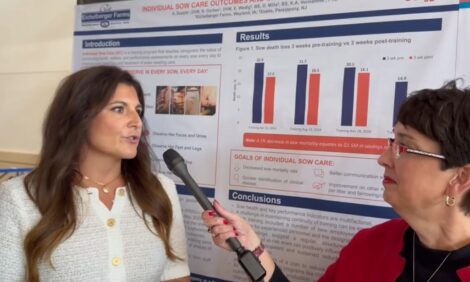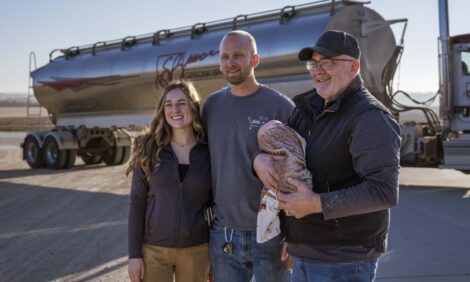



AASV: Paul Yeske shares research on how to use soybean meal during a swine respiratory challenge
Soybean meal as a tactical or prescriptive ingredient when SRD challenges the herdDr. Paul Yeske, a veterinarian with Swine Vet Center, speaks to The Pig Site’s Sarah Mikesell at the American Association of Swine Veterinarians annual conference in Nashville, Tennessee, USA, in late February.
Editor’s note: this interview has been edited for length and clarity.
Tell us about the soy research you shared with your veterinarian colleagues today and your message.
I spoke about soybean meal as a tactical ingredient, and how we can use soybean meal in a different way than how we've typically thought about it. In a study conducted a few years ago looking at different levels of lysine and whether it was high or low soybean meal – they had a respiratory disease challenge and what they found was that the pigs on the higher soybean meal content diets performed better and had better average daily gain (ADG). The research team thought that was interesting and have gone on to do some more work to see if that finding can be replicated.
Is this some of the first research that demonstrates this mitigating effect on respiratory disease?
Yes, I believe that it is. In 2010, Dean Boyd and his group at The Hanor Company conducted a study where a respiratory disease broke, and they had an opportunity to look at this and some others have followed up with additional studies showing the same effect. Again, it's not necessarily new work but it hasn't been featured in a lot of publications, and we’re just trying to get the word out that it's something for producers to consider.
Is there more data for producers to consider now?
Yes, absolutely. We are trying to understand what the mechanism is, and I'm not sure we fully understand what the mechanism is yet. But researchers have looked at whether the soybean meal was high or low and they’ve tested multiple lysine levels. What they found was the soybean meal has a greater impact than the lysine. Both had an impact, but the level of soybean meal was first in the hierarchy versus the lysine level. This indicates soybean meal had a greater impact on performance.
Alternatively, this could be the result of other functional bioactive compounds that are in soybean meal that are not well understood like isoflavones or other biopeptides that are generated during the digestive process. All those could play roles here, and researchers are working to identify a correlation to the mitigation of the impact of respiratory disease.
Are there interactions between these functional bioactive compounds and the pig immune system?
Yes, the isoflavones. Work done at the University of Illinois showed that when we put those back in, we got better performance. When they had soybean meal without isoflavones and when they put them back in, they were able to reduce some mortality significantly in a PRRS challenge pig. I was looking at a PRRS challenge so certainly a little bit more than what we might see in the field but given the opportunity to look at that interaction, we can show that it’s likely having an impact.
In the presentation, you mentioned the hidden cost of SRD. Tell us more.
In the first study, the group really didn't understand the impact of respiratory disease, and I think sometimes the impact is undervalued. I've spent a lot of time working with PRRS and Mycoplasma over the years. One of the things we've seen as we've eliminated these diseases is that we see better ADG and better average feed conversion, and that's what they were able to see here too. When we remove the pathogens, we can mitigate some of those negative effects.
Can you tell us more about what is meant by soybean meal as a tactical or prescriptive ingredient in mitigating the severe effects of swine respiratory disease?
It’s thinking about soybean meal like we would think about our traditional treatments – it's more of a prescription. If I've got a respiratory health challenge in my pig flow, soybean meal is something I can prescribe or use as a tactical advantage to try and help those pigs through that challenge. It really sets up a better environment for the pigs to perform.
Do producers understand their prevalence and what agents their herds are dealing with within the SRD complex?
I think it's a challenge for producers. Certainly, there are different levels of understanding but the key is having a good diagnostic profile to be able to understand what agents you're dealing with. Is it PRRS? Is it Mycoplasma? And understanding when the organisms are being active in the herd. We can do some things such as profiling the herds by looking at serology over time – whether we do it as a cross-section in one day, looking at multiple ages, or whether we follow a group over time through the finishing phases and understand where those pathogens are being active and how we might make some changes and at what times that might be important.
How could producers evaluate soybean meal as a prescriptive solution to reducing SRD-related losses?
Conducting their own trials is always the best way to evaluate because every pig is a little different, every health status is a little different and the organism levels are a little different. If you can do the research and it shows there's an advantage, it’s helpful to see how much of an advantage there is in your particular production flow. So if you make the changes, what's the impact going to be and does it show the return that you’re expecting?
The key questions are:
- Can we get better ADG?
- Can we get that better feed conversion?
- Does it pay for itself at the end of the day?
It’s ideal to trial it at a research barn because you can get multiple reps. When we do them barn-to-barn, it's a little more dirty. There’s a lot more background noise when we look at the data because you're looking at whole closeout data. Some of the advantages can be lost in the noise of the data and it’s not that it's not real, we just didn't pick it up.
But you'd want to be doing that trial when you have a challenge, right?
Yes, absolutely. Again, it’s important to know your diagnostics, know where your flow is at and determine when to take a closer look at this. It’s late February now, and we’re coming through PRRS season and as we came through December and January, we had more herds turn PRRS positive.
This tells us we're getting some more PRRS-positive flows out there and they're getting out into the wean-to-finish phase. That's the opportunity to look at it and determine if this is something that we can do to help ourselves through respiratory challenges?
What is the difference between soybean meal compared to other feed ingredients?
I’ve always thought of soybean meal as an amino acid source. I hadn't really thought of it as a “tactical ingredient” or an ingredient I could use to help with respiratory disease. But looking at this data, I think it's certainly promising and I think it's something that herds need to consider, particularly if you've had an active PRRS break or if you've got a PRRS- and Mycoplasma-positive flow and you're having some activity. It's certainly a good thing to look at and consider if it could make a difference on your operation.
What are the key takeaways you want our listeners and particularly your veterinarian colleagues to understand about this topic?
I think soybean meal is something to consider that we may not have considered in the past that could be helpful. When we get stuck in these situations where we have active respiratory challenges, this is another tool we can use to help mitigate or reduce some of the effects. It's probably not going to make it perfect, but it's an opportunity to help reduce the challenge and get back to where we'd like to be for performance. You've got to understand what you've got – do the diagnostic and then look at where it makes sense to deploy these tactical ingredients and when we could use those to our advantage.








